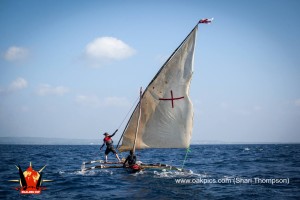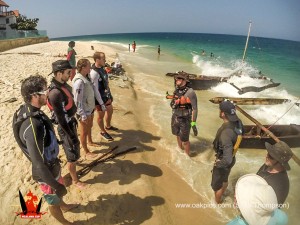11 February 2016
The Ngalawa Cup (Part One)
A sailing adventure in the Indian Ocean.
by Alexander Nimmo
 Like so many great ideas, this one began in the pub. My friend Rory and I had both recently decided to leave our jobs and take some time off. Over a drink he got out his phone, showed me a video then said, “What do you think?”
Like so many great ideas, this one began in the pub. My friend Rory and I had both recently decided to leave our jobs and take some time off. Over a drink he got out his phone, showed me a video then said, “What do you think?”
My initial response was “This is madness, it looks like you can actually die doing this!”
“Exactly!” was his reply. “I think we should do it.”
The plan was to sail a traditional East African outrigger canoe, called an ngalawa (normally used for short inshore fishing trips) in a race over 500km (300 miles) from Pemba Island, north of Zanzibar, to the Tanzanian mainland close to the border with Mozambique, all for charity. We were joined by a third team member, Tom, who works as a research scientist in London. Tom’s general attitude to life can only be described as ‘relaxed, ready for a challenge’. (In 2015 he and a friend kayaked the length of the Thames in five days as a result of a pub bet).
The adventure was being organised by The Adventurists, the company behind the Mongol Rally. In total there would be nine teams of three, with one person obliged to be qualified at least to RYA Day Skipper level. Although there would be safety boats on standby, we were to carry all our kit with us in the boat. This meant limited electronics, and to streamline ourselves we decided all gear had to fit into three 40-litre dry bags.
The trip was billed as being ‘a Challenge’; and the challenges started from the very first day, when we found ourselves at Addis Abbaba airport with a delayed connection that meant we would miss our flight from Dar Es Salaam to Pemba. There were only a couple of flights a day to the island and we were due to be catching the last one. The second issue arose when it transpired that Tom’s bag was still at Heathrow. We knew we would be on Pemba for only two nights, so we had the dry bag sent to Zanzibar to keep our options for pick-up open. Until that time, Tom had only what he was standing up in.
We decided that if we at least got to Zanzibar then we could probably get to Pemba by ferry or maybe even charter flight. The last flight to Zanzibar was leaving at 17.30 and we managed to book, pay for and board the flight in 27 minutes! On Zanzibar we had a lucky break – the two rescue boats had been delayed and we were able to make our way to meet them for an early departure the following day.
 Training began on the 28th for two days, which was barely enough time to get used to the boats. None of us had ever sailed anything this rustic, and although there were not many ropes it looked incredibly difficult to actually get right! All the jokes about them being hollowed-out logs with what resembled a bed-sheet for a sail were spot on. They leaked, were unstable, hard to manage and did not sail much past 90° degrees to the wind. The first day of sailing we were abandoned by our local skipper who, having taken us to the wrong beach, did not want to sail back upwind! We decided that now seemed as good a time as any to go solo, so tried to follow the other four boats which had also gone to the wrong beach. We managed about 200 yards before we were hit by a large gust and the boat began to heel slightly. Unlike a modern boat it transpires that the ngalawa doesn’t accelerate in a gust, and if you don’t ease the sail out and turn upwind they then tend to capsize!
Training began on the 28th for two days, which was barely enough time to get used to the boats. None of us had ever sailed anything this rustic, and although there were not many ropes it looked incredibly difficult to actually get right! All the jokes about them being hollowed-out logs with what resembled a bed-sheet for a sail were spot on. They leaked, were unstable, hard to manage and did not sail much past 90° degrees to the wind. The first day of sailing we were abandoned by our local skipper who, having taken us to the wrong beach, did not want to sail back upwind! We decided that now seemed as good a time as any to go solo, so tried to follow the other four boats which had also gone to the wrong beach. We managed about 200 yards before we were hit by a large gust and the boat began to heel slightly. Unlike a modern boat it transpires that the ngalawa doesn’t accelerate in a gust, and if you don’t ease the sail out and turn upwind they then tend to capsize!
Once we had righted the boat we found that they also have a tendency, when filled with water, to float exactly at the surface, making bailing them out all but impossible. After an hour of exhausting ourselves the rescue boat came across and towed us to shore so we could bail in the shallows. We were then towed back out to sail into the beach we were meant to be getting to. Unfortunately, still being very unfamiliar with these boats, we struggled to get the sail set on the correct side. Eventually as it was getting dark we gave up and the rescue boat towed us into shore. We all felt very dispirited and took small consolation in the fact that three other teams had also capsized that day. This was not an auspicious start!
On 31st December we set sail for Zanzibar and the official start on New Year’s Day. Resolutions did not form any part of our New Year’s Eve celebrations – other than the resolve to complete the race! The 30-mile crossing was calm and easy; despite the stories of huge waves and currents that we had heard about we encountered none of this, although being in such a small boat well out of sight of land for several hours was daunting. However, during this crossing one boat fell apart completely, and another capsized then flipped all the way over and was unrecoverable.
That evening one of the boats dragged its anchor and disappeared downwind, prompting the start to be delayed by a day while the organisers rushed around attempting to buy new boats. Our boat’s anchor cable snapped overnight and the boat drifted away, but was luckily picked up undamaged by a dive boat who (for a small fee) towed it back.
Following the frantic but successful efforts to get replacement boats, the official start kicked off a day late on the 2nd of January…
Did Alexander and his crew complete the race? Did they survive the race? Find out next week in Part Two of The Ngalawa Cup.
Please click here if you would like a weekly email on publication of the Shaw Sheet

